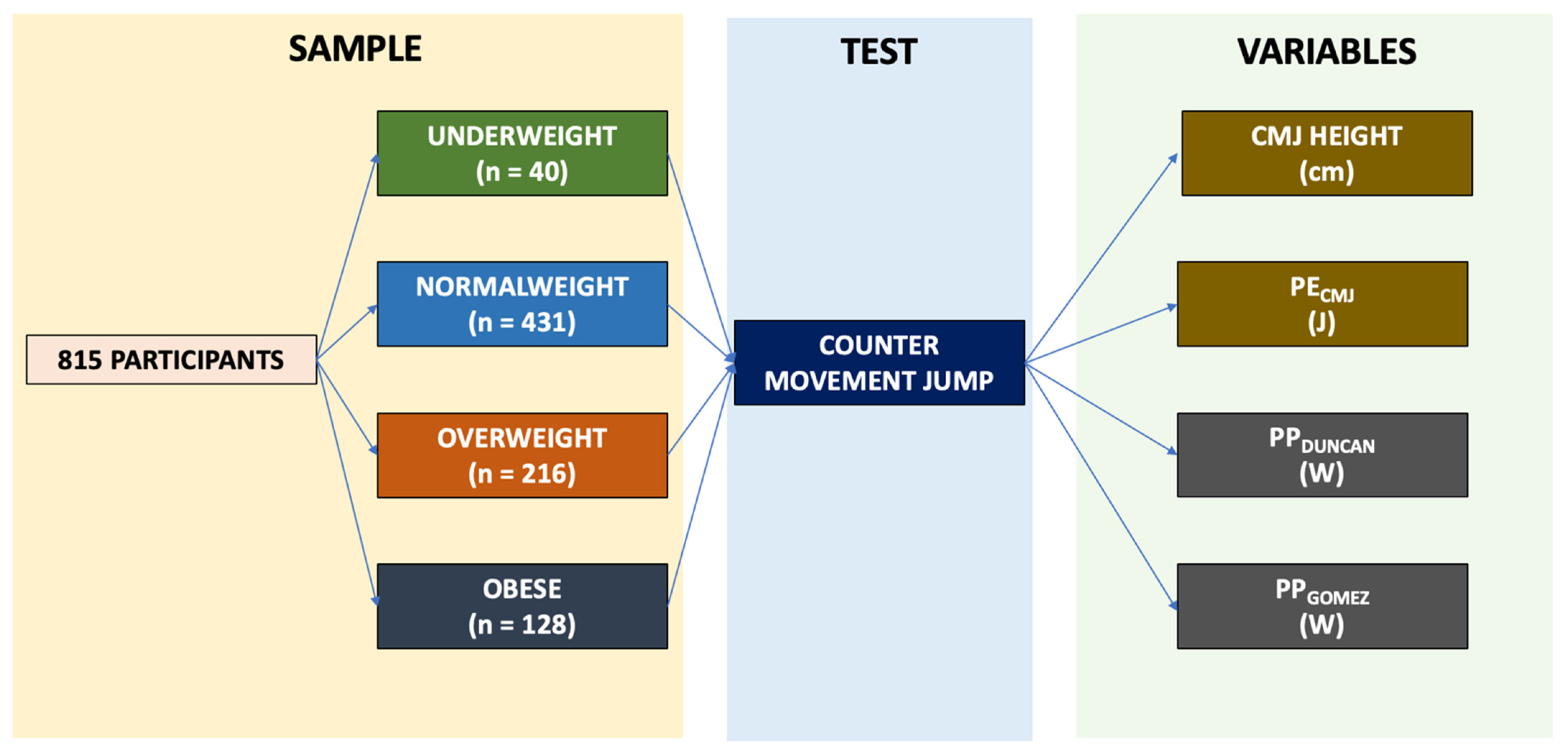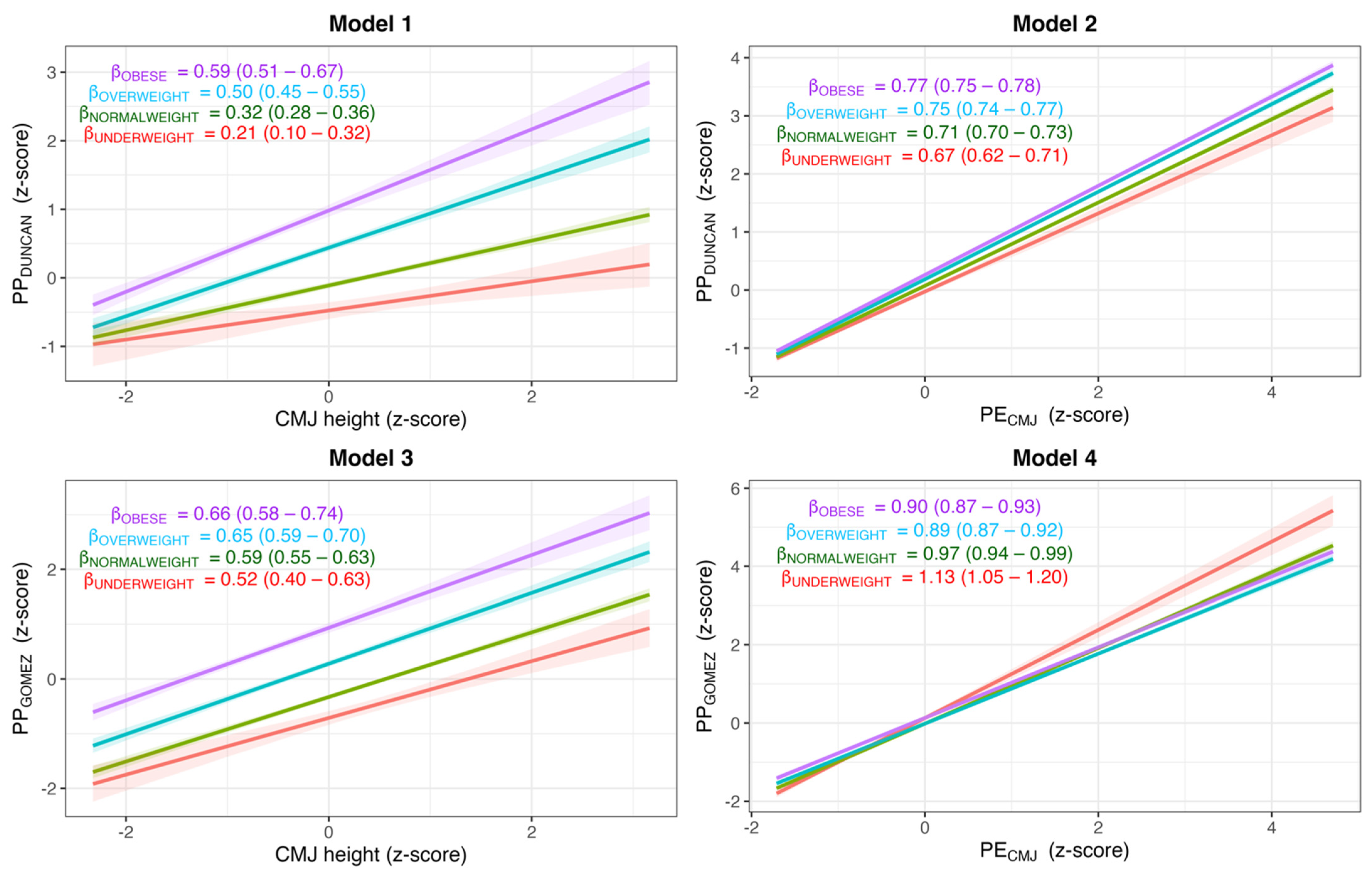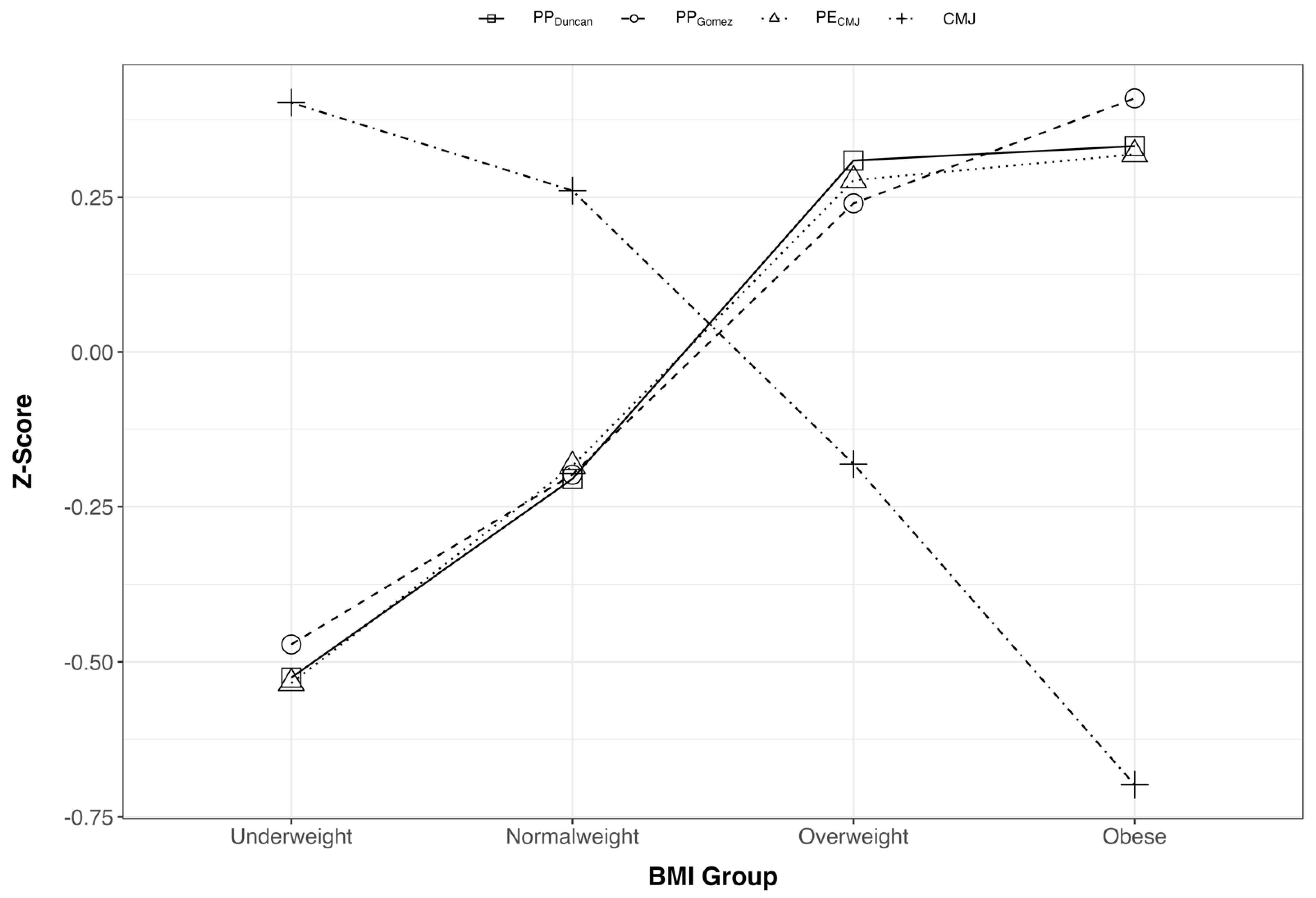Potential Energy as an Alternative for Assessing Lower Limb Peak Power in Children: A Bayesian Hierarchical Analysis
Abstract
:1. Introduction
2. Materials and Methods
2.1. Study Design
2.2. Participants
2.3. Anthropometric Measurements
2.4. Countermovement Jump Test
2.5. Potential Energy
2.6. Statistical Analysis
| yi~Normal (ui, σ) | [likelihood] |
| ui = α + β1Age + β2Sex + β3BMIGROUP + β4Predictor + β5Predictor: BMIGROUP | [linear model] |
| α~StudentT (0, 2, 3) | [prior for intercept] |
| β1~Normal (0, 2) | [prior for effect of age] |
| β2~Normal (0, 2) | [prior for effect of sex] |
| β3~Normal (0, 2) | [prior for effect of BMIGROUP] |
| β4~Normal (0, 2) | [prior for effect of predictor] |
| β5~Normal (0, 2) | [prior for effect of the interaction predictor: BMIGROUP] |
| σ~HalfStudentT (0, 2, 3) | [prior for residual standard deviation] |
3. Results
4. Discussion
5. Limitations of the Study
6. Conclusions
Author Contributions
Funding
Institutional Review Board Statement
Informed Consent Statement
Data Availability Statement
Conflicts of Interest
References
- Ruiz, J.R.; Castro-Piñero, J.; España-Romero, V.; Artero, E.G.; Ortega, F.B.; Cuenca, M.A.M.; Enez-Pavón, D.J.; Chillón, P.; Girela-Rejón, M.J.; Mora, J.; et al. Field-Based Fitness Assessment in Young People: The ALPHA Health-Related Fitness Test Battery for Children and Adolescents. Br. J. Sports Med. 2011, 45, 518–524. [Google Scholar] [CrossRef] [PubMed]
- Taylor, W.; Baranowski, T. Physical Activity, Cardiovascular Fitness, and Adiposity in Children. Res. Q. Exerc. Sport 1991, 62, 157–163. [Google Scholar] [CrossRef] [PubMed]
- Ruiz, J.R.; Castro-Piñero, J.; Artero, E.G.; Ortega, F.B.; Sjöström, M.; Suni, J.; Castillo, M.J. Predictive Validity of Health-Related Fitness in Youth: A Systematic Review. Br. J. Sports Med. 2009, 43, 909–923. [Google Scholar] [CrossRef] [PubMed]
- Castro-Piñero, J.; Artero, E.G.; España-Romero, V.; Ortega, F.B.; Sjöström, M.; Suni, J.; Ruiz, J.R. Criterion-Related Validity of Field-Based Fitness Tests in Youth: A Systematic Review. Br. J. Sports Med. 2010, 44, 934–943. [Google Scholar] [CrossRef] [PubMed]
- Castro-Piñero, J.; González-Montesinos, J.L.; Mora, J.; Keating, X.D.; Girela-Rejón, M.J.; Sjöström, M.; Ruiz, J.R. Percentile Values for Muscular Strength Field Tests in Children Aged 6 to 17 Years: Influence of Weight Status. J. Strength Cond. Res. 2009, 23, 2295–2310. [Google Scholar] [CrossRef]
- Fogelholm, M.; Stigman, S.; Huisman, T.; Metsämuuronen, J. Physical Fitness in Adolescents with Normal Weight and Overweight. Scand. J. Med. Sci. Sports 2008, 18, 162–170. [Google Scholar] [CrossRef]
- Deforche, B.; Lefevre, J.; De Bourdeaudhuij, I.; Hills, A.P.; Duquet, W.; Bouckaert, J. Physical Fitness and Physical Activity in Obese and Nonobese Flemish Youth. Obes. Res. 2003, 11, 434–441. [Google Scholar] [CrossRef]
- Casajús, J.A.; Leiva, M.T.; Villarroya, A.; Legaz, A.; Moreno, L.A. Physical Performance and School Physical Education in Overweight Spanish Children. Ann. Nutr. Metab. 2007, 51, 288–296. [Google Scholar] [CrossRef]
- Harman, E.A.; Rosenstein, M.T.; Frykman, P.N.; Rosenstein, R.M. The Effects of Arms and Countermovement on Vertical Jumping. Med. Sci. Sports Exerc. 1990, 22, 825–833. [Google Scholar] [CrossRef] [Green Version]
- Canavan, P.K.; Vescovi, J.D. Evaluation of Power Prediction Equations: Peak Vertical Jumping Power in Women. Med. Sci. Sports Exerc. 2004, 36, 1589–1593. [Google Scholar] [CrossRef]
- Gomez-Bruton, A.; Gabel, L.; Nettlefold, L.; Macdonald, H.; Race, D.; McKay, H. Estimation of Peak Muscle Power from a Countermovement Vertical Jump in Children and Adolescents. J. Strength Cond. Res. 2019, 33, 390–398. [Google Scholar] [CrossRef] [PubMed]
- Sayers, S.P.; Harackiewicz, D.V.; Harman, E.A.; Frykman, P.N.; Rosenstein, M.T. Cross-Validation of Three Jump Power Equations. Med. Sci. Sports Exerc. 1999, 31, 572–577. [Google Scholar] [CrossRef] [PubMed]
- Amonette, W.E.; Tufano, J.J.; Brown, L.E.; Spiering, B.A.; De Witt, J.K.; Dupler, T.L.; Tran, T.T. Peak Vertical Jump Power Estimations in Youths and Young Adults. J. Strength Cond. Res. 2012, 26, 1749–1755. [Google Scholar] [CrossRef] [PubMed]
- Duncan, M.J.; Hankey, J.; Nevill, A.M. Peak-Power Estimation Equations in 12- to 16-Year-Old Children: Comparing Linear with Allometric Models. Pediatric Exerc. Sci. 2013, 25, 385–393. [Google Scholar] [CrossRef] [PubMed] [Green Version]
- Cole, T.J.; Bellizzi, M.C.; Flegal, K.M.; Dietz, W.H. Establishing a Standard Definition for Child Overweight and Obesity Worldwide: International Survey. Br. Med. J. 2000, 320, 1240–1243. [Google Scholar] [CrossRef] [PubMed] [Green Version]
- Cole, T.J.; Flegal, K.M.; Nicholls, D.; Jackson, A.A. Body Mass Index Cut Offs to Define Thinness in Children and Adolescents: International Survey. Br. Med. J. 2007, 335, 194–197. [Google Scholar] [CrossRef] [Green Version]
- Fernandez-Santos, J.R.; Ruiz, J.R.; Cohen, D.D.; Gonzalez-Montesinos, J.L.; Castro-Piñero, J. Reliability and Validity of Tests to Assess Lower-Body Muscular Power in Children. J. Strength Cond. Res. 2015, 29, 2277–2285. [Google Scholar] [CrossRef]
- García-López, J.; Peleteiro, J.; Rodgríguez-Marroyo, J.A.; Morante, J.C.; Herrero, J.A.; Villa, J.G. The Validation of a New Method That Measures Contact and Flight Times during Vertical Jump. Int. J. Sports Med. 2005, 26, 294–302. [Google Scholar] [CrossRef]
- Depaoli, S.; van de Schoot, R. Improving Transparency and Replication in Bayesian Statistics: The WAMBS-Checklist. Psychol. Methods 2017, 22, 240–261. [Google Scholar] [CrossRef]
- Gelman, A.; Goodrich, B.; Gabry, J.; Vehtari, A. R-Squared for Bayesian Regression Models. Am. Stat. 2019, 73, 307–309. [Google Scholar] [CrossRef]
- Vehtari, A.; Gelman, A.; Gabry, J. Practical Bayesian Model Evaluation Using Leave-One-out Cross-Validation and WAIC. Stat. Comput. 2017, 27, 1413–1432. [Google Scholar] [CrossRef] [Green Version]
- Bürkner, P. brms: An R Package for Bayesian Multilevel Models Using Stan. J. Stat. Softw. 2017, 80, 1–28. [Google Scholar] [CrossRef] [Green Version]
- R Core Team. R: A Language and Environment for Statistical Computing; Foundation for Statistical Computing: Vienna, Austria, 2020. [Google Scholar]
- Bosquet, L.; Berryman, N.; Dupuy, O. A Comparison of 2 Optical Timing Systems Designed to Measure Flight Time and Contact Time during Jumping and Hopping. J. Strength Cond. Res. Natl. Strength Cond. Assoc. 2009, 23, 2660–2665. [Google Scholar] [CrossRef] [PubMed]
- Lara, A.J.; Abián, J.; Alegre, L.M.; Jiménez, L.; Aguado, X. Assessment of Power Output in Jump Tests for Applicants to a Sports Sciences Degree. J. Sports Med. Phys. Fit. 2006, 46, 419–424. [Google Scholar]
- Shetty, A.B. Estimation of Leg Power: A Two-Variable Model. Sports Biomech. 2002, 1, 147–155. [Google Scholar] [CrossRef]
- Lara-Sánchez, A.J.; Zagalaz, M.L.; Berdejo-Del-Fresno, D.; Martínez-López, E.J. Jump Peak Power Assessment through Power Prediction Equations in Different Samples. J. Strength Cond. Res. 2011, 25, 1957–1962. [Google Scholar] [CrossRef]
- Moir, G.; Sanders, R.; Button, C.; Glaister, M. The Influence of Familiarization on the Reliability of Force Variables Measured during Unloaded and Loaded Vertical Jumps. J. Strength Cond. Res. 2005, 19, 140–145. [Google Scholar] [CrossRef]
- Hatze, H. Validity and Reliability of Methods for Testing Vertical Jumping Performance. J. Appl. Biomech. 1998, 14, 127–140. [Google Scholar] [CrossRef]



| Variables | All | Underweight | Normal-Weight | Overweight | Obese | |
|---|---|---|---|---|---|---|
| Sex (n (%)) | Boys | 399 (49) | 16 (40) | 212 (49) | 110 (51) | 61 (48) |
| Girls | 416 (51) | 24 (60) | 219 (51) | 106 (49) | 67 (52) | |
| Age (years) | 8.6 ± 1.7 | 8.8 ± 1.6 | 8.6 ± 1.7 | 8.9 ± 16 | 8.4 ± 15 | |
| Height (cm) | 136.7 ± 11.8 | 136.2 ± 11.3 | 135.0 ± 11.7 | 139.5 ± 11.7 | 138.1 ± 11.3 | |
| Weight (kg) | 35.9 ± 11.1 | 25.5 ± 4.6 | 30. 7 ± 6.9 | 41.0 ± 9.5 | 48.2 ± 12.0 | |
| BMI (kg/m2) | 18.9 ± 3.7 | 13.6 ± 0.7 | 16.6 ± 1.4 | 20.7 ± 1.8 | 24.8 ± 2.9 | |
| CMJ height (cm) | 23.8 ± 5.8 | 26.2 ± 5.8 | 25.3 ± 5.7 | 22.8 ± 5.3 | 19.8 ± 4.5 | |
| PECMJ (J) | 8.5 ± 3.3 | 6.8 ± 2.3 | 7.9 ± 3.0 | 9.5 ± 3.5 | 9.6 ± 3.6 | |
| PPDUNCAN (W) | 922.7 ± 340.2 | 743.9 ± 243.4 | 852.9 ± 307.7 | 1027.9 ± 356.5 | 1035.8 ± 359.7 | |
| PPGOMEZ (W) | 1007.0 ± 489.5 | 776.1 ± 403.3 | 909.9 ± 457.6 | 1124.5 ± 487.1 | 1207.6 ± 512.2 | |
| Outcome | PPDUNCAN | PPGOMEZ | ||
|---|---|---|---|---|
| Predictor | CMJ Height | PECMJ | CMJ Height | PECMJ |
| Model | 1 | 2 | 3 | 4 |
| Model comparison | ||||
| R2 | 0.88 (0.87–0.88) | 0.99 (0.99–0.99) | 0.86 (0.86–0.87) | 0.97 (0.97–0.97) |
| LOOIC | 620.9 ± 50.8 | −1453.4 ± 94.5 | 619.9 ± 51.3 | −601.5 ± 66.1 |
| ELPD | −310.5 ± 25.4 | 726.7 ± 47.2 | −346.0 ± 25.6 | 300.7 ± 33.0 |
| ELPDDIFF | 1037.0 ± 45.9 | 646.7 ± 35.2 | ||
| Parameter estimates | ||||
| α | −3.88 (−4.05, −3.70) | −1.49 (−1.56, −1.42) | −3.25 (−3.44, −3.07) | −0.19 (−0.30, −0.07) |
| βAGE | 0.39 (0.38, 0.41) | 0.17 (0.16, 0.18) | 0.29 (0.28, 0.31) | 0.04 (0.03, 0.05) |
| βGIRLS | −0.29 (−0.34, −0.24) | −0.26 (−0.28, −0.25) | 0.00 (−0.05, 0.05) | 0.00 (−0.03, 0.02) |
| βNORMALWEIGHT | 0.37 (0.25, 0.49) | 0.10 (0.06, 0.14) | 0.38 (0.26, 0.51) | −0.14 (−0.21, −0.08) |
| βOVERWEIGHT | 0.92 (0.79, 1.04) | 0.21 (0.17, 0.25) | 0.99 (0.86, 1.12) | −0.14 (−0.21, −0.07) |
| βOBESE | 1.46 (1.31, 1.60) | 0.29 (0.25, 0.33) | 1.65 (1.50, 1.80) | 0.00 (−0.07, 0.07) |
| βPREDICTOR | 0.21 (0.10, 0.32) | 0.67 (0.63, 0.72) | 0.52 (0.40, 0.63) | 1.13 (1.05, 1.20) |
| βPREDICTOR:NORMALWEIGHT | 0.11 (0.00, 0.23) | 0.04 (0.00, 0.09) | 0.07 (−0.05, 0.19) | −0.16 (−0.24, −0.09) |
| βPREDICTOR:OVERWEIGHT | 0.29 (0.17, 0.41) | 0.08 (0.04, 0.13) | 0.13 (0.00, 0.26) | −0.23 (−0.31, −0.16) |
| βPREDICTOR:OBESE | 0.38 (0.24, 0.51) | 0.09 (0.05, 0.14) | 0.14 (0.01, 0.29) | −0.22 (−0.30, −0.15) |
| σ | 0.35 (0.33, 0.37) | 0.10 (0.09, 0.10) | 0.37 (0.35, 0.39) | 0.17 (0.16, 0.17) |
Publisher’s Note: MDPI stays neutral with regard to jurisdictional claims in published maps and institutional affiliations. |
© 2022 by the authors. Licensee MDPI, Basel, Switzerland. This article is an open access article distributed under the terms and conditions of the Creative Commons Attribution (CC BY) license (https://creativecommons.org/licenses/by/4.0/).
Share and Cite
Fernandez-Santos, J.R.; Gutierrez-Manzanedo, J.V.; Arroyo-Garcia, P.; Izquierdo-Jurado, J.; Gonzalez-Montesinos, J.L. Potential Energy as an Alternative for Assessing Lower Limb Peak Power in Children: A Bayesian Hierarchical Analysis. Int. J. Environ. Res. Public Health 2022, 19, 6300. https://doi.org/10.3390/ijerph19106300
Fernandez-Santos JR, Gutierrez-Manzanedo JV, Arroyo-Garcia P, Izquierdo-Jurado J, Gonzalez-Montesinos JL. Potential Energy as an Alternative for Assessing Lower Limb Peak Power in Children: A Bayesian Hierarchical Analysis. International Journal of Environmental Research and Public Health. 2022; 19(10):6300. https://doi.org/10.3390/ijerph19106300
Chicago/Turabian StyleFernandez-Santos, Jorge R., Jose V. Gutierrez-Manzanedo, Pelayo Arroyo-Garcia, Jose Izquierdo-Jurado, and Jose L. Gonzalez-Montesinos. 2022. "Potential Energy as an Alternative for Assessing Lower Limb Peak Power in Children: A Bayesian Hierarchical Analysis" International Journal of Environmental Research and Public Health 19, no. 10: 6300. https://doi.org/10.3390/ijerph19106300
APA StyleFernandez-Santos, J. R., Gutierrez-Manzanedo, J. V., Arroyo-Garcia, P., Izquierdo-Jurado, J., & Gonzalez-Montesinos, J. L. (2022). Potential Energy as an Alternative for Assessing Lower Limb Peak Power in Children: A Bayesian Hierarchical Analysis. International Journal of Environmental Research and Public Health, 19(10), 6300. https://doi.org/10.3390/ijerph19106300






